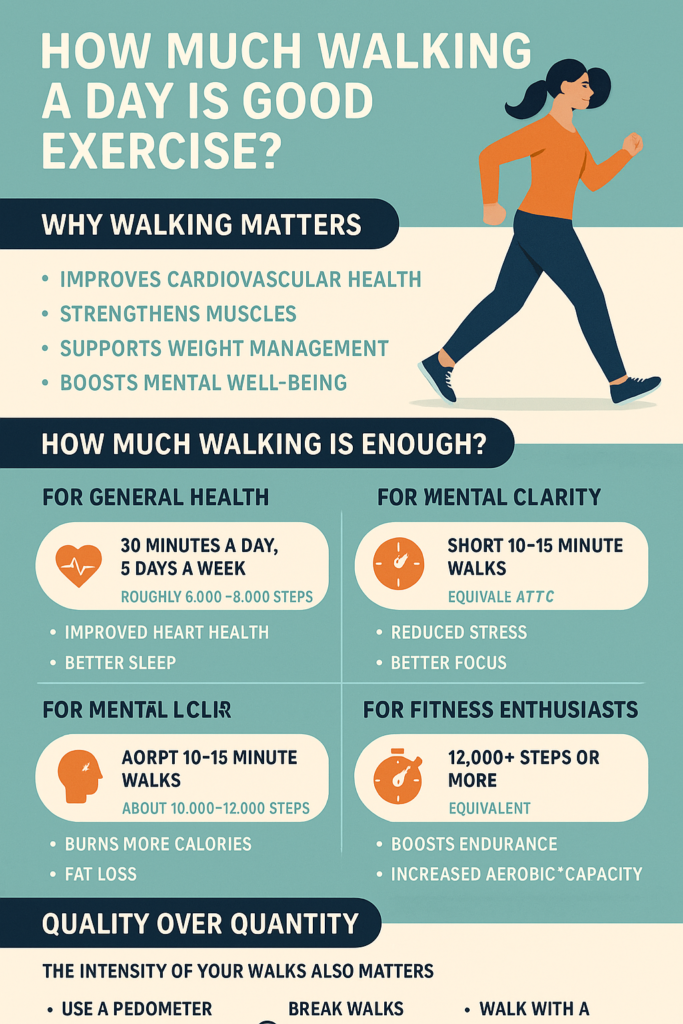In a world where we often associate fitness with intense gym workouts or high-endurance sports, walking can seem like a humble contender. But this simple, accessible activity is actually one of the most powerful forms of exercise you can do. Whether you’re a fitness newbie or an experienced athlete, walking offers numerous physical, mental, and emotional benefits.
So, how much walking a day is considered good exercise?
Why Walking Matters
Walking is a low-impact, moderate-intensity exercise that improves cardiovascular health, strengthens muscles, supports weight management, and boosts mental well-being. It doesn’t require fancy equipment or a gym membership—just a good pair of shoes and the willingness to move.
According to the World Health Organization (WHO) and Centers for Disease Control and Prevention (CDC), adults should engage in at least 150 minutes of moderate-intensity aerobic activity each week, which includes walking.
The 10,000 Steps Myth—And the Reality
You’ve probably heard of the popular “10,000 steps a day” guideline. While it’s a great goal, it wasn’t originally based on scientific research. It began as a marketing slogan for a Japanese pedometer in the 1960s.
Recent studies show that 7,000 to 8,000 steps a day can provide significant health benefits, especially for adults over 40. For younger adults or those trying to lose weight or build endurance, aiming for 10,000 steps or more can be more beneficial.
How Much Walking Is Enough?
Let’s break down walking goals based on health goals and fitness levels:
1. For General Health
- Goal: 30 minutes a day, 5 days a week (150 minutes/week).
- Equivalent: Roughly 6,000–8,000 steps.
- Benefits: Improved heart health, lowered blood pressure, better sleep, mood enhancement.
2. For Weight Loss
- Goal: 45–60 minutes a day.
- Equivalent: About 10,000–12,000 steps.
- Benefits: Burns more calories, supports fat loss, maintains lean muscle mass.
3. For Mental Clarity
- Goal: Short 10–15 minute walks after meals or during breaks.
- Benefits: Reduced stress, improved digestion, better focus and energy.
4. For Fitness Enthusiasts
- Goal: Add intervals, hills, or a brisk pace (3–4 mph).
- Equivalent: 12,000+ steps or more.
- Benefits: Boosts endurance, strengthens leg muscles, increases aerobic capacity.
Quality Over Quantity
It’s not just about the number of steps—it’s also how you walk. Brisk walking, where your heart rate increases but you can still talk, offers more benefits than a slow stroll.
To turn walking into a proper workout:
- Swing your arms naturally.
- Keep your posture upright.
- Engage your core.
- Walk on varied terrain for added challenge.
Tips for Making Walking a Habit
- Use a pedometer or fitness tracker.
- Walk with a friend or pet for accountability.
- Break walks into short sessions throughout the day.
- Choose scenic routes or listen to podcasts/music.
- Walk instead of drive when possible.
Warning Signs You’re Overdoing It
While walking is safe for most people, doing too much too soon can cause:
- Foot or knee pain
- Fatigue or burnout
- Shin splints or joint soreness
Always start slow, wear proper footwear, and listen to your body.
20 Frequently Asked Questions (FAQs)
1. How many minutes should I walk per day?
30 to 60 minutes per day is ideal, depending on your fitness goal.
2. Can I split my walk into multiple sessions?
Yes! Three 10-minute walks are as effective as one 30-minute walk.
3. Is walking better than running?
Walking is lower impact and safer for joints; running burns more calories but has a higher injury risk.
4. Is 10,000 steps a day necessary?
Not necessarily. Even 7,000–8,000 steps daily offer substantial health benefits.
5. Can walking help me lose belly fat?
Yes, combined with a healthy diet, walking helps burn fat and reduce abdominal fat.
6. Do I need to walk every day?
Ideally yes, but aim for at least 5 days a week.
7. Should I walk after meals?
Yes, a 10–15 minute walk post-meal improves digestion and blood sugar levels.
8. Can walking tone my legs?
Yes, consistent walking strengthens and tones leg muscles.
9. What’s the best time to walk?
Anytime! Mornings boost energy; evening walks reduce stress and aid sleep.
10. Does walking improve mental health?
Absolutely. It helps reduce anxiety, depression, and mental fatigue.
11. What pace should I walk at?
Aim for a brisk pace—where talking is easy but singing is hard.
12. Is walking a cardio exercise?
Yes, walking is a form of aerobic exercise that boosts cardiovascular health.
13. Can I walk barefoot?
Only in safe, clean environments. Otherwise, use supportive footwear.
14. Is treadmill walking as good as outdoor walking?
Yes, both are effective. Outdoor walking adds the benefit of fresh air and changing terrain.
15. How can I track my steps?
Use a smartphone app, smartwatch, or pedometer.
16. What if I have joint pain?
Consult your doctor. Walking in water or using walking poles may reduce impact.
17. Can walking reduce cholesterol?
Yes, regular walking helps lower bad cholesterol and increase good cholesterol.
18. Will walking help with diabetes?
Yes, walking improves insulin sensitivity and lowers blood sugar.
19. How can I stay motivated to walk daily?
Set goals, track progress, find a walking buddy, and keep it fun.
20. What should I eat before a walk?
A light snack like fruit, yogurt, or nuts can provide energy if needed.
Final Thoughts
Walking is one of the simplest and most effective ways to stay healthy. Whether you’re walking around your block, through a park, or on a treadmill, consistency is key. Start small, stay regular, and enjoy the benefits that come one step at a time.




